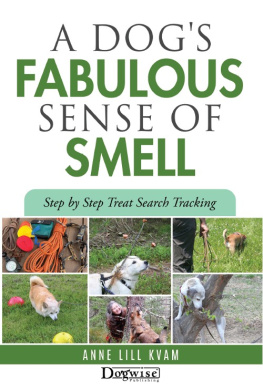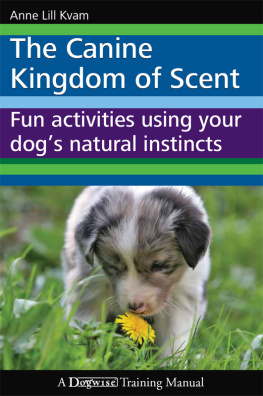
To Fant
My little warrior

I am proud of the reception that my first book The Canine Kingdom of Scent has received for the past several years from people all over the world. Based on the popularity of the concept of search games that the book introduced, I have been able to reach a wide audience through DVDs, seminars and courses. Over time, my courses have been continuously updated and modified as new knowledge and ideas came to me. This has been and still is a rewarding process for me. Students on two and four legs, large and small, young and old gave me valuable feedback in their own ways. What you will see in this new book reflects the same process of renewal.
My interest in search games came as a result of my years with training my own dog for search work, followed by the training of mine detection dogs in Angola, and finally giving courses world-wide. Based on the experience with my own dogs, I teach simple procedures of varied search games for dogs, starting from hiding toys inside a living room, and then moving on to tracking down lost persons or animals, and finally scent discrimination. The students I have worked with vary from ordinary dog owners with a wide variety of experience who want to learn some new training techniques using search games, to professional dog trainers and search and rescue people. The techniques used are presented in a step-by-step fashion for each search game and in each chapter.
All my work with and around dogs, including those in this book, has the same goal: namely to increase the chances that every dog gets to use his nose and senses for something fun or useful as well stimulating every single day.
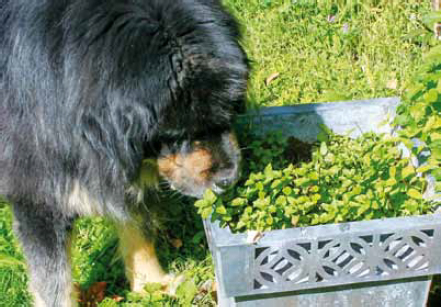
I wonder if I will find any treats here? This Tibetan Mastiff enjoys an uninterrupted sniffing session.
A focus on the dogs natural language and behavior
A running theme in my work with and around dogs is my love for them as a species and as individuals, and respect for their needs and natural language and behavior. In fact, rather than working with dogs I prefer to think of it as cooperating with dogs. We seem to be more occupied by getting results and answers when we actually should be more concerned about the way forward and the upcoming questions.
What happened to the awe and wonder over what our dogs do and why, that many of us had as children? I regained much of that not with a dog, but rather with Chico, the tiny young Vervet monkey I had in Angola. Unfortunately, in parts of Africa baby monkeys were, and maybe still frequently are, sold as pets after their mothers are shot and killed. The image of a monkey baby clinging on to the dead mother still haunts me. So, I take it my little Chico was rather traumatized. To be able to train him for anything, I needed to study his behavior to learn his preferences and dislikes. What made him react like this or like that? After living together a couple of weeks, the day of the first and biggest test arrived: I let him off leash. The young monkey rushed like a tiny furry blizzard up to the top of the incredibly high eucalyptus tree and disappeared. As soon as I had regained my breath, I put my plan into action. I had trained him to come when called and this was the exam. I called Chico, come! and he quickly screamed his little scream of recognition from the treetop before he came scurrying and jumping back to collect his strawberry. I had learned that he found strawberries to be rewarding, and he knew I would reward his behavior.
Rewarding desired behaviors
The training methods I describe in this book are all free from physical punishment, threats and unpleasantness. I prefer to plan the training so that the dog himself will choose to do what I want. Then the challenge is to make sure it pays off well enough to increase the likelihood of the dog repeating this particular behavior in the future. I sometimes like to call this interaction cooperating rather than training.
In dog training, many things can happen, and good contingency plans will be needed. This makes it necessary to be able to observe each dog to find the adjustments necessary to encourage any dog during your encounter doing what you wish. Due to this, you may find it necessary to make your own little adjustments to the recipes I have provided you in this book. Maybe your dog shows you a totally different way of doing it which may be an enrichment for both of you. Maybe you learn that your dog does not like a particular game at all. If so, then drop it. And try out one of the other chapters in this book. Rather than falling for the temptation of helping your dog to solve a task, I suggest that you consider an entirely new task which you make slightly easier.
You may find it useful to make your own notes in this book, or in a special journal. Take notes of what you did, and how it worked.
Each chapter is written as a separate and independent recipe. The exception is the chapter on tracking which builds on the chapter on Pancake tracking.
Troll, the fabulous Standard Poodle who was with me when I wrote this book, has left me now. Still, I choose to let her stay on the pages where I think she serves well, and because she was sort of a co-writer of this text.
I strongly hope that you and your dogs will find great pleasures and usefulness in my book. I wish you many wonderful sniffer-sessions together.
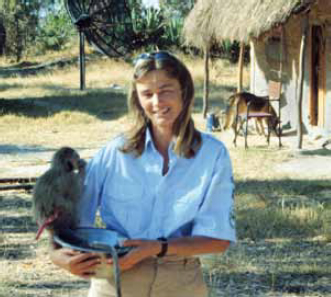
Anne Lill with Chico.

When did you last sense the smell of water?
My dog Troll can smell water from far away. So can dogs in dry areas like deserts; otherwise, they would not be able to live there. Additionally, Troll can hear water, especially when it is a cheerful and tempting murmuring creek or waterfall. I can hear waterfalls too, but not anywhere as far away as she can.
On the other hand, Troll cannot see people standing still in the distance. But I can. This is why a person easily can hide from her by standing motionless next to a tree or between some trees. But as soon as the person moves, Troll can spot this person. One day Troll was barking while looking out the window. None of us people could see anything suspicious out there, but she persisted. Eventually we could see what it was: on a slope some 100 meters away a group of roe deer were moving between the trees. Were it not for the white tails, we two-legged ones would never have spotted them.
All of us sharing lives with dogs have noticed that their senses are superior to ours in many ways. How conscious are you of your dogs senses? Do you really know how well your dog can see, smell or hear? Have you thought of the fact that your dog has a priority of how to deploy his senses in various circumstances?
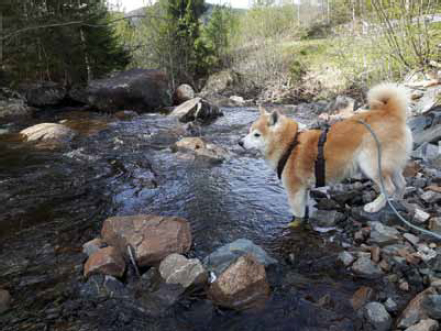
My Fant can smell water. Now that he is getting old, both his sense of vision and hearing have declined and he spends a lot more time sniffing.
Just like us, dogs can see, smell, hear, taste and feel, but they also have a sense of balance. Additionally, just like you and me, they have a sense of the condition of and movements in muscles and joints a kinesthetic sense, and a visceral sense which reports the status to their brains. When the dog appears to be having a bad day, it may be one of those two senses reporting that something is not quite right. Be particularly attentive to the subtle signs dogs may show when they are having one of those bad days: Unfortunately, we miss most of these subtle signs.
Next page
